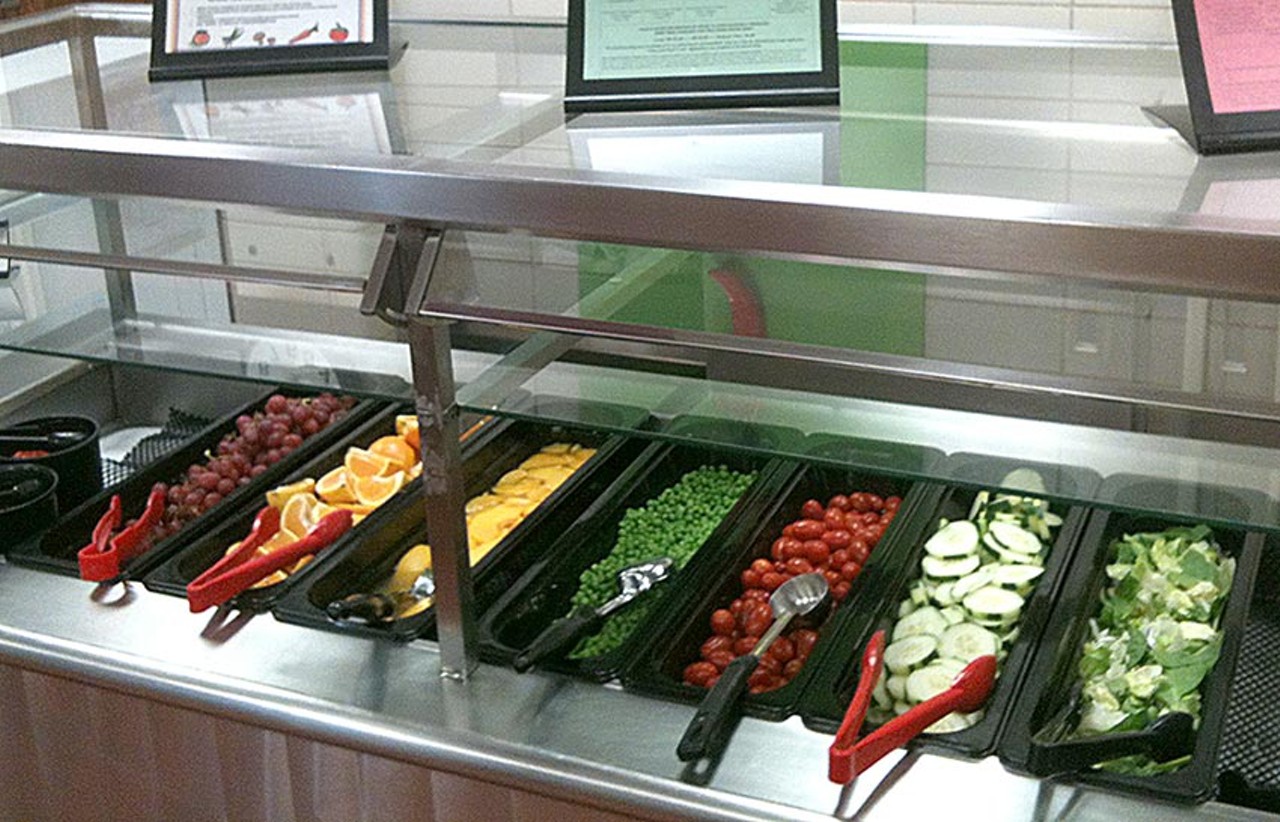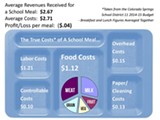by Matthew Schniper | February 25, 2015
“Hey son, what did you have for lunch today at school?”Well, we can tell you one thing Timmy didn’t dine on, if he chose a hamburger, or meatloaf, or pasta with meat sauce: Ranch Foods Direct’s Callicrate Beef. Colorado Springs School District 11 discontinued RFD’s use last month, after seven years, to slash roughly $50,000 from its budget, says D-11 director of food and nutrition services Rick Hughes, who’s also the driving force behind the district’s ambitious Good Food Project.
“We’re funded on a corporate food system, which serves cheap food, and we’re trying to do something different than that,” he says. “But it’s getting to the point with the unfunded [state and federal] mandates that we can’t continue to do things the way we’ve been doing them, and we’re trying not to destroy the whole thing.”
The Good Food Project, implemented in 2009, targets childhood obesity and diet-related illnesses. The district has eliminated foods with artificial dyes, preservatives, hydrogenated oils, excess sugar and sodium, as well as fried items. In their place has come district-wide, from-scratch cooking, plus more fresh fruits and veggies, some grown on the district’s own educational urban farm.
D-11’s efforts have earned statewide awards, but today Hughes says the Good Food Project is “at risk.” He worries he’ll have to begin abandoning healthier food options in favor of lower-cost, higher-margin foods, such as processed foods.
“We are continually being asked to do more to satisfy regulatory requirements with fewer funds,” Hughes says. And, he adds, “Taking money from our already strapped general fund is just not an option for our school district.”
Two bills unveiled at the Colorado Capitol this year underline the vastly different ways that legislators are thinking about kids’ food.
HB15-1088, sponsored by Faith Winter, D-Westminster, seeks to create a grant program to help farmers get more local foods into public schools, to the tune of $1 million annually for five years. The argument — good business for farmers, good food for kids — is fairly obvious, and the bill has made it from the House Education Committee to the Appropriations Committee.
Meanwhile, HB15-1080, sponsored by Rep. Janak Joshi and Sen. Owen Hill, both R-Colorado Springs, sought to limit the state’s “Breakfast After the Bell” program, which ensures kids in poor areas get a free meal to start the school day. This year, the program is scheduled to open to schools with 70 percent or more of students qualifying for free or reduced lunch; Joshi and Hill aimed to keep it at a higher 80 percent threshold.
Before the bill was killed in committee, D-11 found itself in the odd position of pushing for it — in essence, arguing that fewer of its kids should get free breakfasts. In fact, it went so far as to produce videos on the topic, and to post them on the district website (tiny.cc/qelkux).
Its stance has everything to do with finances and mandates. In the video, D-11 gives the example of Henry Elementary School on the east side, where 71 percent of kids qualify for free and reduced lunch. The district’s calculations show that if a free breakfast is offered, 78 percent of kids will take it. Because the federal government offers no reimbursements for food, production or service costs for those extra kids, the district calculates that it would lose nearly $60 per day, or almost $10,000 per year, at Henry due to this program.
That’s just a tiny piece of the numbers game. Here’s another: To receive any federal school lunch program reimbursement money ($3.06 on a free meal, $2.66 on a reduced-price meal and 36 cents on a paid meal), five plate components must be offered: milk, a bread or grain item, a meat item, a vegetable and fruit. When one of those components increases in price, people like Hughes have to find ways to cut costs elsewhere on the plate.
Last summer, Sinton Dairy, which is owned by a multinational company called Borden Milk Products, told Hughes that it was dropping his account. That left Meadow Gold and Robinson dairies, both owned by another multinational called Dean Foods. When Robinson didn’t bid for the contract, only Meadow Gold remained. And it charged 31 cents per half-pint of 1 percent milk, instead of Sinton’s 22 cents, says Hughes. (Meadow Gold did not return our call for a comment ahead of deadline.)
Couldn’t Hughes have shopped around further for the nearly 30,000 kids in his district?
“There are very few manufacturers who have the capacity to not only produce adequate supplies of milk for D-11’s usage, but also who have the packaging systems to package the specialized half-pint containers,” he says.
Ranch Foods’ Mike Callicrate often talks about the near impossibility of competing with the big corporations as a small rancher (see “Castrating a bull“). In this case, the dairy biz proved no different. And more expensive milk directly contributed to D-11’s discontinuing RFD, Hughes says.
Some school districts make do without federal lunch money. Hughes points to the Douglas County School District in Castle Rock, which this past fall opted to take its high schools off the national lunch program. That’s a move it could afford, in part, because only 10 percent of their students are eligible for free or reduced-price meals, as opposed to 59.5 percent in D-11.
Douglas County’s director of nutritional services, Brent Craig, says recent USDA Smart Snacks regulations alone would have “toppled” his program, which is fueled largely on à la carte sales of nine in-school Subway franchises. The district’s healthy foods policy still largely guides high schools, though they’re not “bound by all the regs.” As for elementary and middle schools, he says he struggles with the same regulatory and financial concerns as Hughes.
So, back to our local plates: What will local kids be eating instead of RFD meat?
Most likely a US Foods beef on which Hughes’ team is currently finishing “evaluations.” He insists it has not been treated with ammonia hydroxide — so, no pink slime — though he can’t say whether the animals were treated with hormones and antibiotics. He just knows that it is “approved by the USDA, sold in grocery stores and restaurants around the city, state and country, and consumed by millions of people around the country daily.”
If that doesn’t sound as inspiring as a “Good Food Project,” well, it’s not. From D-11 executive chef Nathan Dirnberger’s point of view, “It is a struggle to maintain our standards for good food while ensuring that we follow the government regulations. We want to do what’s best for the students, but we also need to do what’s best financially for our district.
“Food is such an important tool that will impact the future of our society. My hope is that our community will hear our cries for help and support us as we move forward. Hopefully they understand that many of our decisions are far beyond our control. It will take every member of our community to demand that our society place food, health and wellness of our children as a priority.”
Sounds like a line out of Food, Inc. As it happens, that’s the documentary that Callicrate personally took Hughes to see at its premiere years ago.
“I came out saying, ‘Wow, is it that bad?'” Hughes remembers. “We need to look at what we’re serving our kids. That gave birth to the Good Food Project.”
Whose founder was just forced to give the ax to the guy who inspired it.
That’s what’s for lunch today, Timmy. Cold irony. You want milk with that?
Too bad, you’re getting it.
For Mike Callicrate, an outspoken critic of the “beef cartel” and big believer in building a strong, sustainability-minded regional food system, School District 11’s move away from Ranch Foods Direct products is all too familiar. Inside of the last year, he says, he’s lost business from Greeley, Falcon and Boulder school districts, due to the same kind of financial squeezes. Altogether, he projects losing somewhere in the neighborhood of $1.5 million in revenue from lost school contracts in 2015. It’s a figure that includes the loss of steak-cut sales, which must balance with his ground beef sales in order to move a whole animal through his production line.
“If you don’t have ground beef business, you can’t be in the meat business,” he says, noting that he’s cut four RFD jobs already. “This is a very ugly marketplace, dominated by just a handful of big companies, and they are brutal and ruthless. … We’re really screwed. You can’t shift it this fast.”
Callicrate says he was shocked to see the U.S. government step in last week and sue to block a merger between the country’s two largest food providers, US Foods and Sysco. But it’s not a game-changing victory. Even in today’s market, he often can’t compete with big companies that undercut what he calls his best, barely-break-even price by 25 percent — not when they import inexpensive beef while the overall U.S. herd continues to decline in population and rise in price.
“They’re able to dollar-cost-average the meat they sell … and totally wipe us out of the market. What the heck happened to farm-to-school? To our commitment to feed our kids better and support local economies and ranchers and farmers?” he asks. “The USDA fails to fund these programs they come up with. … And you know damn well these big industries have major lobbying power. …
“But hey, it’s back to performance-enhancing drugs, and pink slime is fully back” — at least in the wider marketplace, if not D-11, for now.
Mike Callicrate is the inventor and owner of the Callicrate Bander a humane, drug-free method of castration.
Watch Jobs That Bite: Castrating a Bull – a 3 minute video program by National Geographic’s Nat Geo Wild hosted by Jeremy Brandt.














